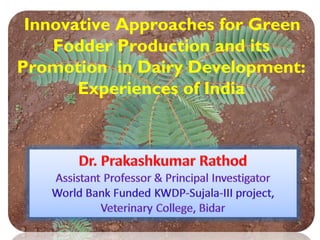This document discusses innovative approaches to green fodder production promotion in India. It notes that fodder production and livestock feeding are critical for dairy development but past promotion efforts faced challenges. A project in Bidar district established fodder nurseries with multiple varieties and trained farmers. This led to increased fodder production area and yield over time among participating farmers. It also motivated other farmers to adopt fodder cultivation through distributing root slips and cuttings, demonstrating horizontal diffusion of the practices. Participating farmers now prefer fodder cultivation due to its benefits.








































